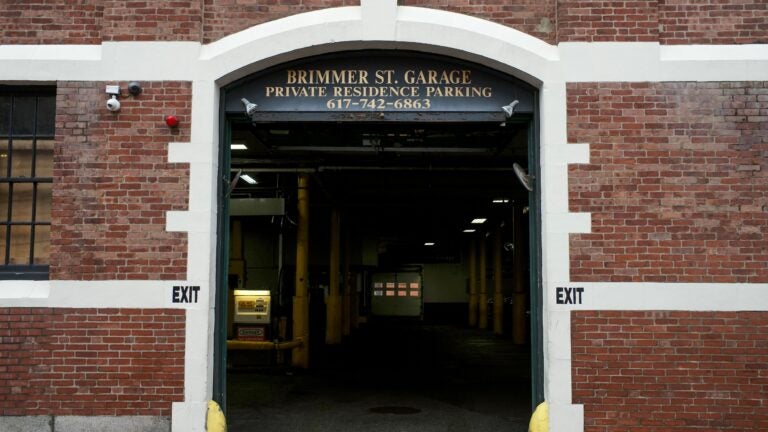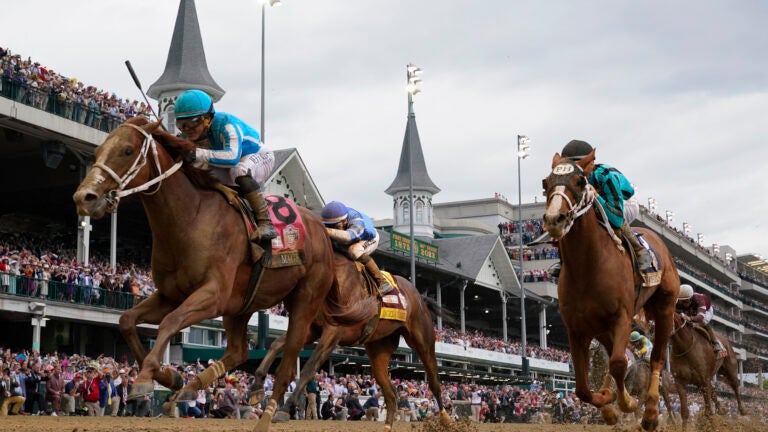This regatta might be the best-kept secret of the sailing world
Every year, close to 100 wooden boats sail up to the remote town of Brooklin, Maine, for nothing but the love of tradition.

“Here, hold this up as we cross the finish line,’’ Taylor Allen said from the cabin.
He handed me a sheet of thick paper with a big number seven printed on it as we sailed back toward the shores of Brooklin, Maine, a good hour after most of the other boats. Being only 60 minutes behind was a small miracle for those of us who sail on Northern Crown in the annual Eggemoggin Reach Regatta—we’re usually out there several hours after the faster, sleeker boats have finished. But the wind was strong this year, and we were flying. Taylor’s three sons presided at the helm and ran the sails.
“If a man must be obsessed by something,’’ E.B. White once wrote, “I suppose a boat is as good as anything, perhaps a bit better than most.’’
Two of E.B. White’s grandsons were on Northern Crown that day. His son Joel was a master boatbuilder who owned Brooklin Boat Yard. Joel’s son Steve, who now owns the business, founded and organizes the regatta with Taylor, who is married to Steve’s sister Martha and owns Rockport Marine, a boatyard 30 miles down the coast from Brooklin. The number I held up as we cruised over the finish was just for show: Northern Crown is a fixture in the race. Any regular could pick her out of a lineup.
An air horn honked as we finished. We cheered and continued past the tall pines and rocky coast of Hog Island and into the cove where boats anchor after the race. Taylor turned on the motor and headed us into the wind as we dropped our sails and scurried to tie up loose lines. We moored and poured rum and tonics as we recapped the day—which boats had run aground (four of them), which had broken various parts in fantastic, wood-splintering ways (two of them), which had to cut away tangled sails (one of them), and which got caught up in lobster traps (most of them, probably).
Some of the wooden sailboats anchored near us were among the most expensive in the country, and Taylor and Steve’s boatyards have built or worked on many of them. The boats’ home ports were painted under the names on their sterns, many of them big ones like Newport or New York City. A few were from Europe. Others were little daysailers that belong to local Mainers and could have used a new coat of paint. Laughter shot up from different boats like fireworks, voices sparking and then fading into the sky.
Unlike many sailing races, the Eggemoggin Reach Regatta has no sponsors. There are no fancy watch or rum companies handing out free stuff. You can’t protest when another boat does something you think is against the rules. There is no easy way to get to Brooklin, Maine, where, years ago, E.B. White moved to get away from New York City. In the small, privileged world of sailing, an event like this one is rare.
What is it about this race? How did the Eggemoggin Reach Regatta come to be the quiet favorite—almost a secret—that few people outside wooden boat circles know about?
[bdc-gallery id=”118869″]
[fragment number=0]
Taylor and Steve’s boatyards build boats that are more works of art than they are modes of transportation. They often work from vintage designs, and also repair antique vessels—floating museums, really, with histories as detailed as a family tree. Theirs are not the industrial looking things that sail in the America’s Cup. They are instead timeless beauties, glorious indulgences.
I grew up teaching sailing with Taylor and Martha’s son, Nick White, and for years I’ve sailed with them on Northern Crown, a 35-foot Aage Nielsen cutter built in the 1950s that originally belonged to Joel. The boat is heavy and wide, with thick beams and a weighty hull that can handle high wind.
Northern Crown might not be fast, but some wooden boats, such as Steve’s 55-foot square-meter Vortex, are. Even so, it’s hard to compete with modern fiberglass and carbon fiber technology.
“Out of the racing you could do [in the 1980s], you didn’t have much chance of winning if you had a wooden boat,’’ Steve told me. “So we thought it’d be fun to have a race where people with wooden boats could have a chance to win trophies.’’
And so the Eggemoggin Reach Regatta was born. No one’s exactly sure when, but back around 1984 or 1985, Steve asked the people at WoodenBoat, a school for boat building in Brooklin, if he could use their cove as anchorage. WoodenBoat agreed, and their field near the water has become host to the barbecue and the dance party that follow the race, when Steve gets up on the band’s makeshift stage and announces the winners, who receive a pewter cup and an inside joke.
That first year—either 30 or 31 years ago, depending who you ask—nine wooden boats entered. This summer, there were 93.

[fragment number=1]
“We’ve got the guy who can just barely afford to keep his boat and get it in the water, who can’t afford to buy the next quart of paint,’’ Steve said. There are, of course, wildly wealthy people who enter the race, too. But at the E.R.R., many of the men and women who build the boats sail aboard with the men and women who commission them.
“I don’t think that’s completely common everywhere,’’ Steve continued. “If you’ve got a 30-foot sailboat and that’s all you can afford to own and keep going, you can still enter for 75 bucks, and that’s all it’ll cost you. You don’t have to rent dock space. You can’t rent dock space.’’
By comparison, races like the Panerai Classic Yachts Challenge regattas, sponsored by the European watchmaker and held in Marblehead, Newport, Nantucket, Antigua, and Cannes, require that you rent dock space. And that’s the least of your costs. If you want to have a shot at holding your own, you have to pay a professional crew. Doing so—with housing, travel, fuel, and food covered—comes to about $500 per person per day. Most large, professionally run boats require a crew of around 15 people. A season on the race circuit can easily cost $2.5 million.
Jamie Enos captains the yacht Saphaedra for the boat’s owner, who lives in New York City. She regularly races in the competitive, sponsored circuit, from New England down to the Caribbean. We sat below deck in Camden Harbor where she and her brother Brock, her first mate, were cleaning the boat Monday after the E.R.R.
“Up here, it’s different from the other races. It’s a bunch of Mainers sailing for the love of it,’’ she said. Sharkbait, the cat who lives on board, padded around. Jamie and Brock found him at a bar in Antigua and took him back to the boat, where he’s lived ever since. He doesn’t like to swim.
Unlike the streamlined production of other races, something always goes wrong at the E.R.R. Sometimes it’s the thick fog that creeps in, or the multiple collisions, or when someone invariably runs aground on one of the sneaky ledges that seem to sprout up in front of your boat. My grandfather used to say that if someone who sails in Penobscot Bay tells you they’ve never hit rocks, they’re lying.
Roger Angell, E.B. White’s stepson and The New Yorker editor, in his book of essays called Let Me Finish, recalls asking his half-brother Joel if he’d ever hit a certain ledge. ‘“Two or three times, easy’ [Joel] said. ‘We were there last in September’—he’d been aboard his Danish-built, Aage Nielsen cutter Northern Crown, with his son Steven and daughter-in-law Laurie, among others—’And we smacked it hard. Laurie was in the head and she fell off the pot.’’’
I laughed when I read this account. It’s funny, but my reaction was more one of surprise: Taylor told that same story during the race this summer as we sailed past a boat stuck on a ledge.

[fragment number=2]
We sailed Northern Crown back to Rockport the Sunday after the race, motoring along until the wind picked up. Taylor wore a wide-brimmed hat tied underneath his chin. He steered the boat with his knee.
Taylor’s sister Lucia Michaud, who works at Rockport Marine, is the mastermind behind the event. She and a team of volunteers spend months coordinating it. The volunteers are what keep the E.R.R. free of sponsorship money that brings, in Steve’s words, “all the stuff we didn’t want with it, like advertising on mailings and a hospitality booth at the party afterwards.’’
“It’s unusual for races not to have sponsors. We’ve done that intentionally,’’ Taylor said. The race is a respite from the cutthroat nature of other regattas, where winning comes with prestige and prizes worth thousands of dollars.
“One of the things we really like about [the E.R.R.] is the low-key, informal, fun aspect of it,’’ he continued. “That’s important for us to continue. We’ve had sponsors approach us, but we’ve always declined. And we’ll keep declining.’’
We fell into silence for a bit. I could feel the vibrations from the diesel engine beating like a giant heart inside the hull.
“But it’s a function of how long people like Lucia, Richard Stetson, and Bridget Qualey want to keep doing this,’’ he said. “They volunteer a lot of their time and don’t get paid for it. That’s why so many races are sponsored, because somebody gets paid to organize it.’’
Taylor leaned over the side and checked the water ahead of us as we cruised underneath the suspension bridge that links Deer Isle to the mainland. Patchy breeze was starting to fill in ahead of us, and the line of ripples announced that we were getting closer to the wind.
“Hey, you wanna get a sail up?’’ Taylor asked. “Let’s put the main up, and maybe the staysail, and see what happens.’’

[fragment number=3]
Some regulars refer to the race as “Christmas in August,’’ given that far-flung family members trek home for it each year no matter what.
It is ceremonial. On the night before the race, Martha organizes a big dinner at the Little House (named after Stuart Little) on Blue Hill Bay. Both sides of her family sit around the table—Taylor’s brother Ben, his wife, Julie, and their three daughters are fixtures aboard their boat Star Song each year—as well as family friends and people who work at Taylor’s boatyard. We eat lobsters that Martha and Steve’s brother, John, a commercial lobsterman who fishes in the area, catches that day. This year, Martha sat with her son Sam’s child on her lap, a little girl born last year the day after the race.
Stories run together—which year was it that we drifted into a mess of boats around North Haven Island? Nobody can remember. Who was it who got into the rowboat, attached a line, and pulled Northern Crown for an hour when there was no wind? It happens a lot, so it depends which year are you talking about. Where did that ledge come from? Seemingly nowhere.
But the answers don’t matter. What matters is that, in Angell’s words, “The islands here are unchanged except for their thicker recent growths of pine and fir.’’ These days, the island spruces are reaching the end of their 70-year life cycle. They’re not getting thicker anymore—instead, patches of dead pines pierce the sky like spears, their branches rotted off.
Each year the people have changed, too—toughened or softened depending on the tides and winds of the previous 365 days. But the race itself stays the same, beholden only to those who return.








Conversation
This discussion has ended. Please join elsewhere on Boston.com